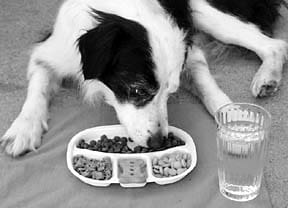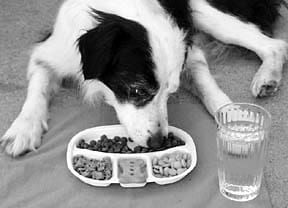I love the commercial where the lady puts down a bowl of new dog food down, and the dog shoves it under the rug. The voice-over gravely intones, “(Our food) . . . every day.” It’s very clever advertising, directly aimed at getting all of your pet food dollars into just one manufacturer’s pocket. But the concept is all wrong.
Imagine that you have a child, a two-year old boy, and you take him to the pediatrician for a checkup. The doctor bustles in, very jovial, looks Junior over, then plunks a big can of “Allinheres” down on the exam table. “Good news,” he beams. “Chef Kidardee has put all the vitamins, minerals, and a perfect balance of nutrients that Junior needs into New Complete Allinheres. Now all you have to do is make sure Junior gets three servings every day.” The doctor wags his finger at you as he continues, “But since this food is perfectly complete and balanced, don’t feed Junior anything else, like apples or oatmeal or broccoli or a peanut butter and jelly sandwich, because it might cause a nutrient imbalance!”
Well, this sounds a little weird, but you trust the pediatrician, and you go ahead and put Junior on a diet exclusively comprised of Allinheres. Junior grows, and it sure is easy and convenient to feed him. The next year you bring him in for his checkup, and the doctor is very pleased.

“He looks great,” says the Doc. “I see you’ve been keeping him on Allinheres. Terrific! Now, I have more good news for you! Allinheres now comes in All Life Stages! You’ll keep him on Allinheres Growth until he starts kindergarten. Then he’ll go on Elementary Allinheres until he hits middle school. Then Adolescent Allinheres until he’s 18, when he can be weaned onto Adult formula. And you can eat it too! It’s complete and balanced for adults up to 65 years old.”
Then he takes a closer look. “Hmph,” he says. “Maybe Allinheres Lite for you.”
Ridiculous? Of course! What rational parent would feed a child only one food for years on end. Even if the food is, in fact, complete and balanced, most of us would consider such a practice unnatural, even cruel to the child. Never give Junior a cracker or a carrot? No fresh food at all? Preposterous!
Then why does everyone think it’s okay to do this very thing to a dog? We would think a pediatrician who recommended a single food diet for a child was bonkers, yet when the veterinarian recommends a single food for our pampered pooch, we obey without question. Yet, feeding a dog is not all that different from feeding a kid. There are numerous reasons why a dog should eat different foods on a regular basis – if not a fresh, ever-changing homemade diet, then at least a rotating commercial diet.
Nutrient imbalances
In the veterinary literature, there are many documented cases of animals with nutritional deficiencies (or excesses), and in virtually every one, the problem arose (or was discovered) because the animal was kept on one food for a long period of time.
Cats, being rather odd creatures with strange dietary requirements, have been the unintended victims more frequently – taurine, copper, vitamin E, and potassium deficiencies have turned up in cats on some foods. Dogs, whose metabolism is more adaptable, haven’t had as many problems, though zinc and fatty acid deficiencies have occurred on certain poor quality foods. An excess of zinc in a commercial dog food sickened author Ann Martin’s dogs and started her on a course of research into commercial pet food manufacturing and regulation, resulting in her book, Food Pets Die For in 1997.
But wait a minute . . . Aren’t we talking about “complete and balanced” foods? How can a complete and balanced food have deficiencies or excesses of nutrients? Unfortunately, even for the best commercial dog food, there are several places along the road to the store shelf where the food’s nutritional value can go astray:
• First, the standards by which the food is made aren’t perfect. Animal nutrition is an evolving science, and we don’t yet know all there is to know about it (if we ever will!).
• Second, the exact amounts of nutrients in a given ingredient may not be known, or may be inaccurately assessed. A batch of cornmeal might be assumed to have a certain nutritional composition, based on past batches of cornmeal, but depending on the weather where the corn was grown, the soil conditions, and the type of fertilizer used, the exact amounts of each nutrient in any one batch can vary quite a bit.
• Third is supplier error. A vitamin-mineral premix added to the food may guarantee minimum levels of each item, but if the quality control on that premix was poor (as it may have been in the food Ann Martin’s dogs ate, which tested very high in zinc), the finished dog food will compound the error.
• Also, because of the nutritional standards themselves, which specify minimums for most nutrients but not maximums, pet food makers may not test for the probability that their finished product is too high in some nutrient. Excesses of certain minerals, for example, can wreak havoc on dogs’ health. Even a wide divergence between the stated and actual amount of something like protein or fat can cause problems for some dogs.
Say you choose a food for your dog, an older, sedentary Spaniel with kidney problems based on its stated protein content of 19 percent – a comparatively low-protein food. But the amount guaranteed on the food labels is a minimum. In other words, the label says the food contains at least that 19 percent protein; it may have much more. After all, some foods are produced on a “least cost” basis, and the ingredients may change significantly from batch to batch. (For more information about “actual” amounts of nutrients in commercial foods, see “Comparing Apples to Apples: The Dry Matter Comparison,” January 2001.)
• On the other hand, some manufacturers develop a formula – a recipe, if you will – for making their food, and they will stick with that recipe no matter what. If their recipe results in a food that is typically at the very low or high end of acceptability for some nutrients, you can imagine that after years of feeding the same food, your dog’s body will eventually exhibit the effects of that chronic over- or undersupply of those nutrients.
We like to think of the production of food, even pet food, as a fairly scientific affair but the truth is, all pet food manufacturers make mistakes in formulation or production that result in nutrient excesses or deficiencies. Look through the state feed control reports from around the country; it becomes obvious that virtually every manufacturer – no matter how good, bad, or indifferent its reputation – at one time or another fails one or more tests for protein, calcium, magnesium, or other nutrients.
Intolerance and allergy
A very different pitfall of feeding a single food for years and years is the potential for your dog to develop an intolerance or allergy to one or more ingredients. Food intolerances and allergies can often cause similar symptoms, but there are significant differences between them.
A dietary intolerance is a reaction to something in the food, but this reaction does NOT involve an immune response. The list of suspects is a long one, and includes food ingredients, as well as additives such as flavoring agents, coloring agents, emulsifiers, humectants, stabilizers, thickeners, text-urizers, and dozens more. Signs of gastrointestinal disturbances (especially vomiting and diarrhea) are far more likely to be caused by food intolerance than by a food allergy. A food intolerance can develop at any time in the dog’s life.
True food allergies – immediate immune responses triggered by exposure to a certain food – are thought to be fairly rare. Food allergy usually causes skin reactions, such as papules, rashes, and ear infections (actually, the inflammation sets up the scene, and then bacteria and yeast that are normally present cause secondary infections). Histamine is part of this reaction; it is a pro-inflammatory chemical that affects the local cells and blood vessels and also summons other inflammatory cells onto the scene.
However, most skin reactions are due to atopy (inhalant allergies); only a small percentage turn out to be caused by food. It usually takes months to years of exposure to a food to develop a food allergy, and food allergies are usually caused by proteins. Proteins are found in animal products, of course, but also to some degree in cereal grains. Thus, switching foods every three or four months, from chicken and corn, to lamb and rice, turkey and barley, or duck and potato, may help prevent your dog from becoming food-allergic in the first place.
Preventing fussiness
The last big reason to periodically change foods is to prevent finicky eating. In a past column (“He Likes It! Hey Mikey!” November 2000) we discussed palatability enhancers, the products that dog food makers use to transform otherwise unappealing processed food into irresistibly tasty nuggets. Consequently, a dog fed a single food may become “addicted” to one particular flavor. Most of us have heard of dogs who will eat nothing but one brand, or even, one flavor made by one brand of food; if the owner runs out of that food the dog goes hungry until the distraught owner manages to find some of the flavor in question. It’s best to have your dog develop more cosmopolitan tastes, and be willing to eat whatever you give her.
Making the switch
For all of the reasons listed above, it’s a good idea to change foods occasionally – as much as every three to four months. There is some evidence in people that avoiding a particular “problem food” for four months may resolve the issue and the body will again tolerate it. Also, that’s a short enough period that allergies are unlikely to develop.
But when you get ready to make the transition from one food to another, be sure to plan ahead. You don’t want to run completely out of one food and just plunk down a bowl of something new in front of Rover’s nose. If you’ve trained him right, he may not push it under the rug, but a sudden switch could cause tummy upset.
For most dogs, a four (or eight) day changeover works best. Young dogs usually adjust quickly; older dogs may need a little more time. For the first day (or two), feed 75 percent of his old food mixed with 25 percent of the new food. After a couple of days, feed 50 percent each of old and new food; then 25 percent of his old food and 75 percent new food, and finally all new food. This gives the dog’s resident gut bacteria time to gear up to handle the new ingredients properly.
For the first two weeks on a new food, monitor your dog’s appetite, stool quality, and energy level, and watch for unusual symptoms – itchiness, runny eyes, diarrhea – that could indicate the food is not right for him. Eventually, you’ll be able to settle on three or four different foods you can rotate between. As always, your dog’s skin and coat quality, activity level, and appetite are the best indicators of whether the food is contributing to his optimal health.
-By Dr. Jean Hofve
Dr. Jean Hofve is the Companion Animal Program Coordinator for the Animal Protection Institute, located in Sacramento, California.






